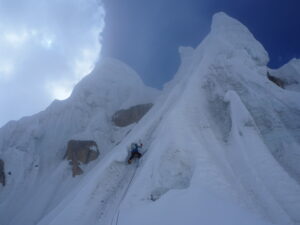Bad weather has settled into the Karakorum, with snow burying the hopes that some teams still had for a final go at their respective goals. Garrett Madison had delayed his departure, hoping that better weather might allow his team to try Broad Peak this week. Ian Welsted and Graham Zimmerman patiently waited for some dry, cold days, essential on a difficult mixed route like K2’s West Ridge.
“We had dinner together yesterday, and I think they are heading home soon,” Madison told ExplorersWeb.
Search ends. Now, what happened?
Madison Mountaineering’s Sherpa team was the first to spot the bodies of Juan Pablo Mohr, Ali Sadpara, and John Snorri, who died on K2 last February. The Sherpas reported the find immediately but no one “touched or moved the bodies”.

The bodies’ location, marked on a photo by Elia Saikaly. Photo shared by The Karakoram Club
“Ali Sadpara was cut loose from the rope, lowered down to near Camp 4, and buried in the snow by Sajid Sadpara and Bolivian Hugo Ayaviri,” Madison said. “J.P. Mohr was found near Camp 4 and buried in the snow as well; Snorri, as far as I know, is still clipped onto the fixed line.”
Saikaly confirmed that Sajid Sadpara moved and buried his father’s body, then performed a religious ceremony. Sajid also buried Mohr and took some personal belongings to return to his family. He also reached Snorri, who was higher up the mountain and not as easy to move.
“He also searched our dear friend John Snorri’s lifeless body for clues and evidence of a winter ascent,” said Saikaly. “It was an incredibly dangerous search just beneath 8,300m. John Snorri was the highest of the three climbers, attached to the winter K2 safety lines installed by the Nepali Sherpas.”

Devices retrieved from Snorri’s remains: A Garmin, a Samsung mobile, and a GoPro.
They were going down
“John, Ali, and JP were all on the descent,” Saikaly added. “Ali Sadpara was a few rope lengths below and Juan Pablo a significant distance away near Camp 4.”
The main question is whether they reached the summit or not. It’s not just idle curiosity: The families have stated that this point is important to them. So we presume that they gave Sadpara and Saikaly, who is filming a documentary about the tragedy, permission to retrieve and use the audiovisual material found on the deceased climbers’ devices.
“Sajid was unstoppable, fueled by a determination only a son can have for his fallen and missing father,” Saikaly said. He also spoke of the effort from two days spent in the so-called death zone and five on the mountain. They were “let down by both of our high-altitude porters and forced to carry their responsibility on our backs,” he added.
The team is currently trekking back to Skardu and starting to view the images from the fallen climbers’ devices. Among them is the only image currently retrievable from John Snorri’s GoPro, shot during their summit push on winter K2.

The only frame obtained so far from Snorri’s GoPro. Photo: Elia Saikaly
Few clues so far
“This is the only piece of visual information that we have at the moment. A single frame of video which is corrupt [and] will need further analysis,” he said. “The date is incorrect, logged as February 7, 2019.”
Saikaly has shared the image and wondered where that image could have been shot. He mentioned that the “heroic Nepali Sherpas who summited K2 in winter would recognize this rope, as they installed it.”
NIrmal Purja immediately answered on Saikaly’s Instagram that he knew exactly where that pic has been taken. “Chat later,” Purja wrote.
On social media, opinions are divided between those hoping to see the mystery solved, and others suggesting that sharing details and images from the deceased climbers is disrespectful. We have indeed omitted some details posted on Instagram and will not publish some sensitive images. But research may eventually explain what happened to Sadpara, Snorri, and Mohr on winter K2. This is of public interest and may bring some peace to relatives and friends.





